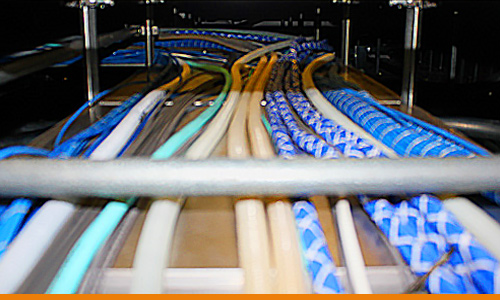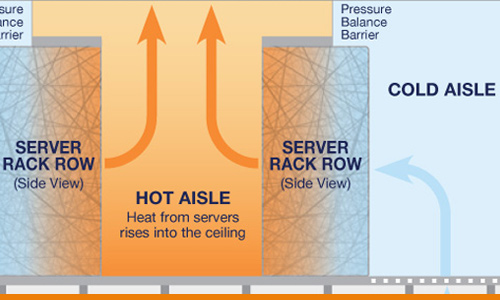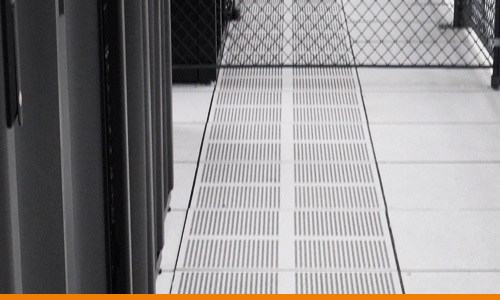What’s Under the Floor in a Data Center Server Room?
November 16, 2015The Ideal Habitat for a Data Center Servers
When you tour a Data Center server room, the first thing you notice is how clean and cool it is. But with all that equipment, where are all the wires and the cables?
In many Data Centers, it’s all under the floor.
A server rack takes a lot of power and generates a lot of heat. The cooling system is crucial to keeping the temperature at an optimal 72 degrees to prevent overheating, which can cause reduced server performance or equipment failure. Other than the many rows of servers, the only equipment you see in a server room are the power distribution and cooling units.
A raised floor allows more even distribution of cooled air with less wasted energy. The natural effect of heat rising pushes the hot air up and out through ductwork more efficiently.
“Hot aisles” and “Cold aisles”
The aisles between the server racks have very different purposes. In the hot aisle, fans in the back of the server equipment push the heated air to perforated tiles on the ceiling of the hot aisle. This hot air is picked up by an air handler and returned to a CRAC Unit (computer room air conditioning units) to produce cold air in the server rooms.
These CRAC units also are fed with chilled water supply to ensure the correct temperature is
The Data Center Server Room Foundation
A raised floor covers all the “life functions” of a server room— cables, cooling, power outlets and monitoring sensors.
With a raised floor, engineers can identify the physical location of servers for quick access in the event of an emergency, as grid numbering is assigned to the raised floor tiles.
The area below the floor is called the plenum. Generally, the plenum can be anywhere from 12-36 inches deep. The plenum acts as a conduit for airflow, while the perforated tiles allow air into the room ONLY where it will most effectively cool the equipment. Achieving true raised floor plenum requires a completely sealed environment so that air can only escape through the perforated tiles.
Raised floors must also be strong enough to support the weight of metal racks loaded with servers. There are a variety of types of raised floors, but they fall into 4 basic categories:
- Stringerless Raised Floors consist of an array of pedestals set at the proper height for routing cables. Pedestals support each corner of floor panels and provide accessibility to the space under the floor.
- Stringered Raised Floors consist of steel pedestals placed on 2-foot centers fastened to the concrete floor.
- Structural Platforms are platforms of steel channels welded or bolted together into a platform to support equipment. Data centers can bolt equipment to the platform.
- Truss assemblies — utilizes attachment points to the subfloor that support a truss network on which the floor panels rest. The truss has high lateral strength and transfers lateral loads to the subfloor with less strain than possible with a vertical pedestal assembly.
Data Centers can offer customizable solutions to support all four raised floor types.

Copper cables may be many different colors, but normally the blue cables are copper, and the aqua are fiber. Groups of cables, either fiber or copper may be wrapped with Coreflex, which acts as a container to isolate and protect them.
The Cabling Under the Floors
The raised floor is home to an extensive network of wires and cabling. Connectivity to each server from the IDF (Intermediate distribution frame) runs under the floor and takes such forms as CAT5/6, single mode fiber, and multimode fiber. Power to each rack unit also runs under the floor along with ground wires throughout. One can find cables for the fire suppression system under the floor as well.
Backup systems, consisting of uninterruptible power supplies, battery banks, and generators, are NOT under the floor. They typically have a room of their own. To prevent single points of failure and allow for full scale repairs, all elements of the electrical systems, including backup systems, are duplicated.
What’s the ideal temperature for Data Center servers?
The standard range of server-room temperatures is between 68 and 74 degrees. Ideally, data centers try to keep server room temperatures right at 72 degrees, with a 48% humidity level.
Monitoring the Systems
Ethernet ports and switches along the server room walls correspond to physical locations. Remote engineers can monitor room temperature, consistent power usage, and server operation via the building monitoring system, whereby the software in the room reports information to the administrative computer in the Engineering office.
The next time you visit a Data Center, look down. The hidden world below you houses the “life support” systems for the critical equipment you see above.



